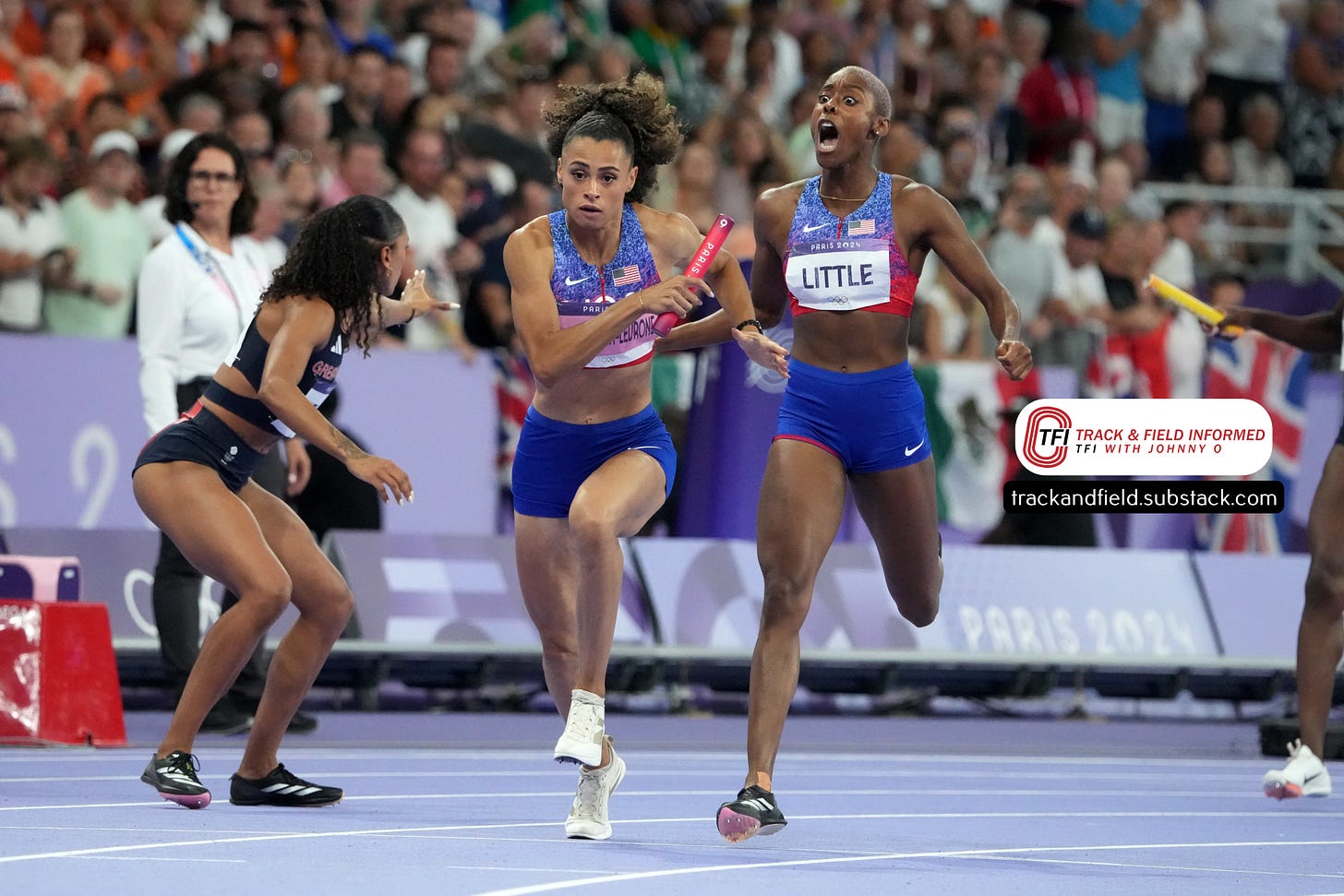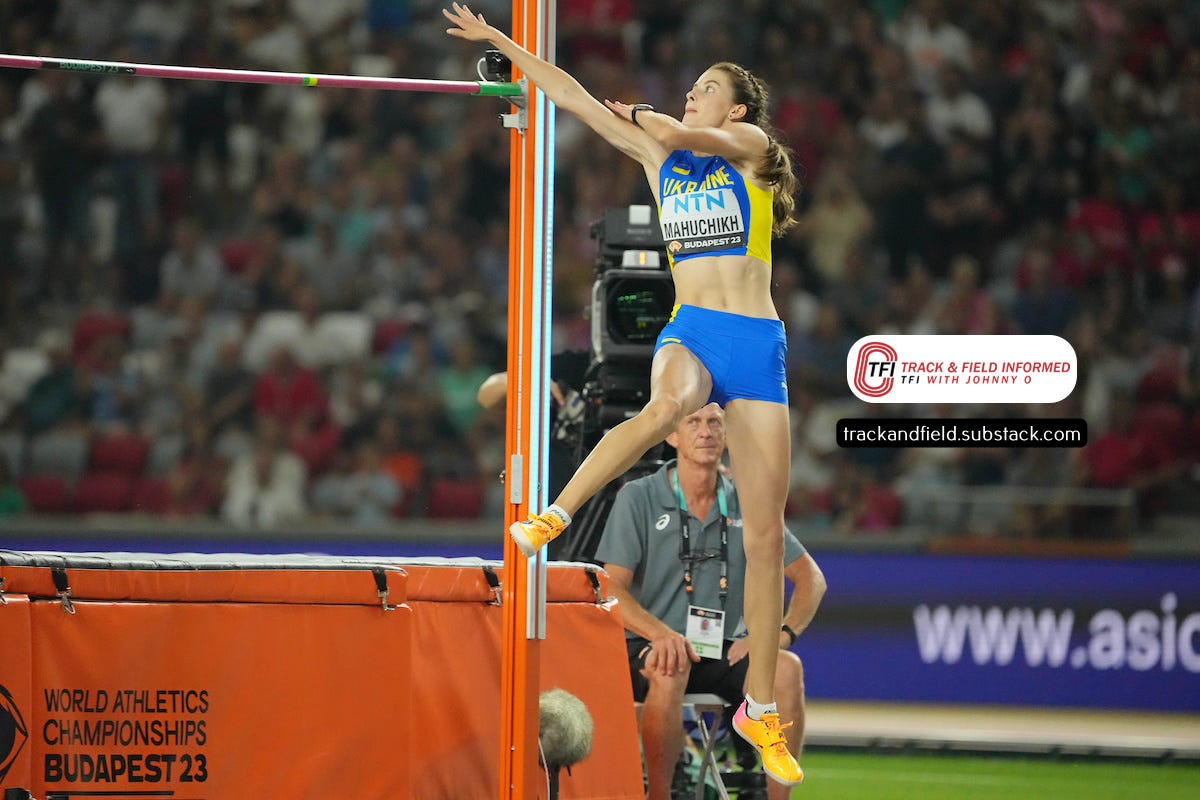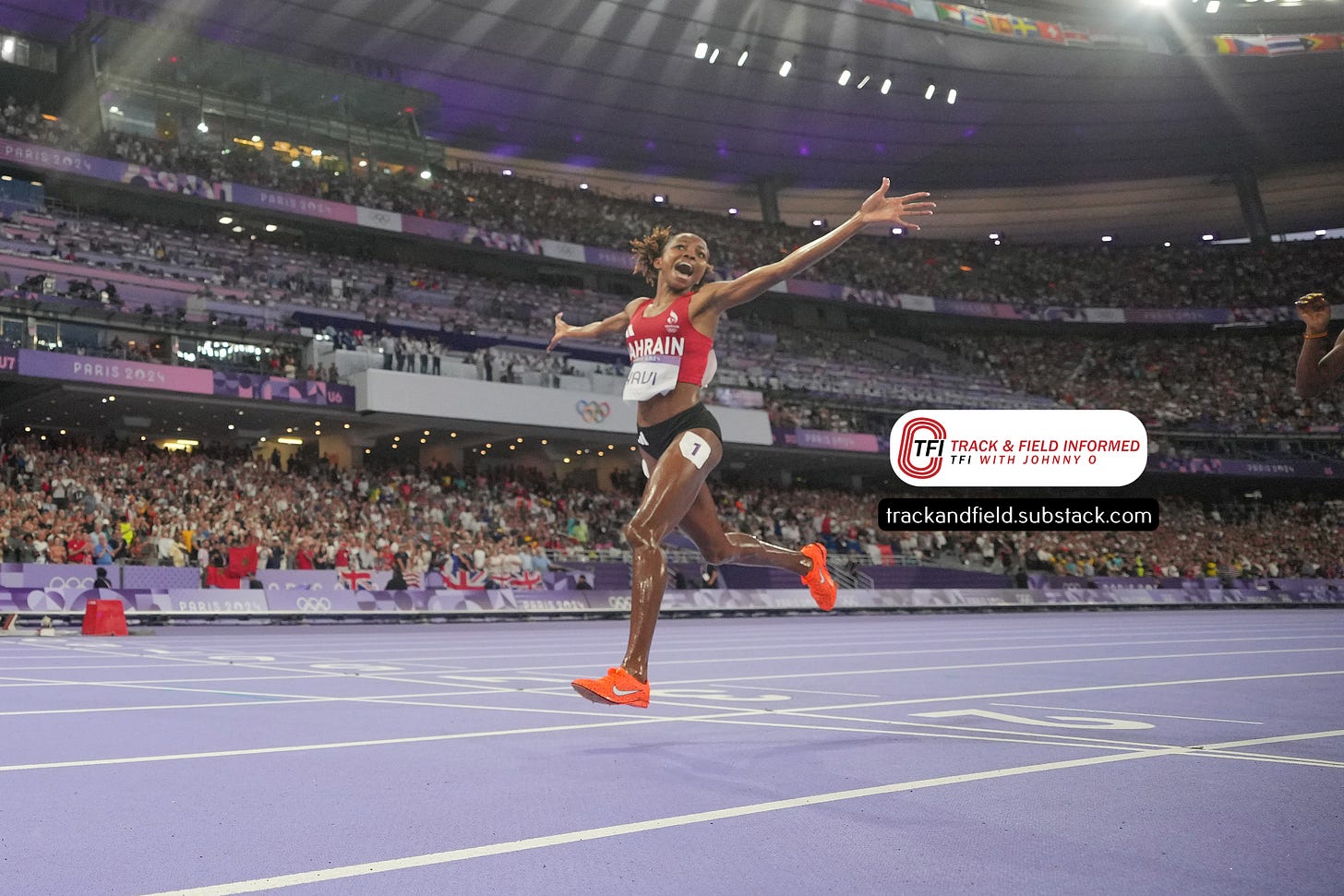McLaughlin-Levrone branches out
Two world records in 400 hurdles, excellence in three events lead to American's selection as women's athlete of the year

I realize there are plenty of track and field fans who wish that Sydney McLaughlin-Levrone would race more frequently.
And some of them, based on their online posts, feel that she should not be eligible for athlete of the year awards because she doesn’t compete often enough.
But when it came to 2024, McLaughlin-Levrone ran in as many individual finals — nine — as Marileidy Paulino of the Dominican Republic, and in more finals than Faith Kipyegon of Kenya and fellow American Sha’Carri Richardson, who each competed in eight.
While nine individual finals is not a lot, McLaughlin-Levrone packed a ton of quality into that small quantity of races during a season in which she set a pair of world records in the 400 hurdles, ran 48.75 seconds in the 400, and lowered her personal best in the 200 to 22.07 in a race in which she finished well ahead of eventual Olympic champion Gabby Thomas of the U.S.
Her world-record clocking of 50.37 in the 400 hurdles in the Olympic Games in Paris was the performance that ultimately led me to choose her as the women’s athlete of the year for 2024.
Beatrice Chebet of Kenya won the 5,000 and 10,000 meters in Paris after setting a world record of 28:54.14 in the 10,000 in the Prefontaine Classic in May, and Yaroslava Mahuchikh of Ukraine won the Olympic title in the high jump after breaking a 37-year-old world record when she cleared 2.10 meters (6 feet 10¾ inches) in the Meeting de Paris in July.
However, I ultimately chose McLaughlin-Levrone over either of them as the women’s athlete of the year because her 50.37 performance came in the pressure-cooker atmosphere of the Olympic Games, which is a more challenging environment in which to excel than in an invitational such as the Pre Classic or the Meeting de Paris.
“It was an amazing year. I’m so grateful being able to be healthy coming back from last year,” McLaughlin said in a World Athletics post that was written after she had been announced as the women’s track athlete of the year at the governing body’s annual gala in Monaco on Dec. 1. “The ultimate glory goes to God. I am so super-honoured to be here.”
A knee issue led McLaughlin-Levrone to withdraw from the 400 in last year’s World Athletics Championships in Budapest, Hungary, and she eventually called it a season after having run in only four individual finals. But she returned to the 400 hurdles this year and drew ever closer to breaking the magical 50-second barrier in the event.
“That definitely is on my mind for sure,” she said of running under 50.00 in the World Athletics post. “An athlete would naturally want to do that. Whether that happens or not is up to God. I’m just going to work for it, I can’t put a number on it.
“It may be me, or maybe an athlete in five or 10 years from now. So I’m just going to continue to try to be the best I can be and if it comes it comes, and if it doesn’t, it doesn’t. But I think for me it’s just the desire to improve. Every time you go back to the table and look at it, there is always something you can do better. It’s exciting in the hurdles, that there is always something you can improve on.”
McLaughlin-Levrone began her season on April 20 when she ran a leg on a 4 x 100 relay team that clocked 42.93 seconds while finishing second in the Mt. San Antonio College Relays in Walnut, California.
She then ran 12.71 in the 100 hurdles and a wind-aided 22.38 in the 200 in winning those events in the Oxy Invitational at Occidental College in Los Angeles on May 4.
She ran another 200 two weeks later in the USA Track & Field Los Angeles Grand Prix at UCLA’s Drake Stadium and her performance in that race caught a lot of people’s attention as her personal best of 22.07 left her well in front of Americans Abby Steiner and Brittany Brown, who finished second and third, respectively, with times of 22.32 and 22.35.
Thomas, who would win the Olympic title in Paris in a time of 21.83, finished sixth in 22.68.
“Pretty good,” McLaughlin-Levrone said when NBC Sports’ Lewis Johnson asked how she felt about her performance. “For running a 200, it was acceptable. I was hoping to go under [22]… so I’m happy with it.”
She then ran 52.70 in winning the 400 hurdles in the Edwin Moses Legends Meet at Morehouse College in Atlanta on May 31 before clocking another then-yearly world-leading time of 48.75 to place first in the 400 in the USATF New York City Grand Prix on Randalls Island on June 9.
If not for cool and blustery conditions that forced her to battle a stiff headwind on the backstretch during the race, she probably would have broken the American record of 48.70 set by Sanya Richards-Ross in 2006.
Her next meet was the U.S. Olympic Team Trials in Eugene, Oregon, and after running 53.07 in a first-round heat on June 27 and 52.48 in a semifinal two days later, McLaughlin-Levrone capped the eight-day competition on June 30 by lowering her world record to 50.65.
That performance shaved three hundredths of a second off the world record of 50.68 that she had set in the 2022 World Athletics Championships while running on the same Hayward Field track at the University of Oregon.

That effort bettered McLaughlin-Levrone’s previous world record of 51.41 by such a large margin that plenty of track and field experts wondered if it might stand for a decade or two.
“I wasn’t expecting that,” McLaughlin-Levrone told Johnson of NBC Sports after her winning effort in the Olympic Trials. “I’m just amazed, baffled, and shocked.”
McLaughlin-Levrone would not race again until the Olympic Games in Paris, where she was expected to meet Femke Bol of the Netherlands, the 2023 World champion who had run 50.95, then the third-fastest time in history, in a meet in La Chaux-de-Fonds, Switzerland, in mid-July.
While Bol’s performance had no doubt benefitted from the elevation of close to 1,000 meters (3,280 feet) in La Chaux-de-Fonds, the expected showdown between her and McLaughlin-Levrone was one of the most eagerly-anticipated match-ups in the Olympics.
After running 53.60 in the first round on August 4 and 52.13 in the semifinals two days later, McLaughlin-Levrone was in lane five for the final on August 8, with Bol in lane six and fellow American Anna Cockrell in lane seven.
She had a clear lead over the first of 10 hurdles and although Bol was only .14 seconds behind her after touching down after the fifth barrier, McLaughlin-Levrone’s advantage was twice that after the seventh hurdle, half a second after the eighth, and she entered the home straightaway with a lead of 5-6 meters over the fading Bol.
She eventually finished a second and a half in front of silver medalist Cockrell, whose 51.87 clocking made her the fourth-fastest performer in history. Bol placed third in 52.15 in the first race ever in which five women ran under 53 seconds.
“Grateful to God for this opportunity, grateful to be celebrating my 25th birthday like this. It was yesterday, just a super opportunity, you can’t even imagine,” McLaughlin-Levrone said in a World Athletics post. “It’s amazing to see our sport continue to grow, for people to want to watch 400m hurdles. I knew it was going to be a tough race. An amazing competition all the way round.”
Two days later McLaughlin-Levrone followed the sixth world record of her career in the 400 hurdles with a scintillating 47.71 split on the second leg of the 4 x 400 relay as the U.S. team of Shamier Little, McLaughlin-Levrone, Thomas, and Alexis Holmes won the gold medal by more than four seconds with a 3:15.27 clocking that was only a tenth of a second off the world record set by a Soviet Union foursome in the 1988 Games in Seoul.
While McLaughlin-Levrone would not run in another 400 hurdles race during the year, she capped her season by winning the 400 in 49.11 and the 200 in 22.40 in a pair of invitational races that were held in cool and damp conditions as part of the Diamond League Final that was contested in the Memorial van Damme meet in Brussels from Sept. 13-14.
While McLaughlin-Levrone was not eligible to run in the Diamond League Final races because she had not taken part in any Diamond League meets during the season, she was the first athlete to sign a contract with Grand Slam Track back in June.
Grand Slam Track, which is the brainchild of four-time Olympic gold medal winner Michael Johnson, is a fledgling professional track tour that will kick off its inaugural season with a meet, or “Slam” as it is being called, in Kingston, Jamaica, from April 4-6.
That will be followed by slams at the Ansin Sports Complex in Miramar, Florida, from May 2-4, at Franklin Field in Philadelphia from May 30-June 1, and at UCLA’s Drake Stadium from June 27-29.
As a “Racer” in the women’s long hurdles category, McLaughlin-Levrone will compete in the 400 hurdles and the 400 in each meet, with the opportunity to win $100,000 in prize money in each slam.
Those races will total eight finals, and with the USA Track & Field Outdoor Championships in Eugene from July 31-August 3, and the World Athletics Championships in Tokyo from Sept. 13-21, it is highly likely that McLaughlin-Levrone will compete in at least 10 finals during the upcoming season.
That would be the most finals she has contested since 2018, when she ran 11 individual finals, as well as a lot of relay legs, while competing for the University of Kentucky during her only collegiate season.
“I’m honored to be one of the first Racers in Grand Slam Track,” she said in a GST release. “Michael’s vision is clear, and he’s exactly the leader this sport needs to break new ground. I am thrilled to be a part of this league and look forward to everything we have coming in the future. I firmly believe that this is the step forward that track needs to take it to another level, and I can’t wait to get to work with the team.”
The following individuals comprise the remaining top 10 female athletes for 2024:
2) Beatrice Chebet (Kenya) – The 24-year-old distance runner employed a powerful kick in winning the 5,000 and 10,000 meters in the Olympic Games in August after becoming the first woman in history to run under 29 minutes in the longer race with a 28:54.14 clocking in the Prefontaine Classic in May. She had the two fastest times of the year in the 5,000, with her 14:09.52 and 14:09.82 efforts being the seventh- and eight-fastest ever run. She won both of her 10,000-meter races during the season and was victorious in three of four 5,000-meter contests, with her lone loss coming to Faith Kipyegon in the Kenyan trials for the Olympic Games. In addition to her exploits on the track, she won her second consecutive title in the World Athletics Cross Country Championships in Belgrade, Serbia, in March and set a world 5k road record of 13:54 in the Cursa dels Nassos race in Barcelona, Spain, on Tuesday.
3) Yaroslava Mahuchikh (Ukraine) – The high jumper, who turned 23 in September, was the gold medalist in the Olympics and European Athletics Championships in Rome during an outdoor season in which she broke a 37-year-old world record when she cleared 2.10 meters (6 feet 10¾ inches) in the Meeting de Paris Diamond League meet in July. She was unbeaten in seven meets outdoors after winning two of three meets indoors and finishing second in the World Athletics Indoor Championships in Glasgow, Scotland, in March.

4) Faith Kipyegon (Kenya) – The 30-year-old super-vet started her season later than expected due to an injury, but the 2023 women’s athlete of the year won an unprecedented third consecutive Olympic title in the 1,500 after earning a silver medal in the 5,000. Prior to the Olympics, she had lowered her world record in the 1,500 to 3:49.04 in the Meeting de Paris Diamond League meet in July. She was unbeaten in six finals in the 1,500 and won one of her two races in the 5,000.
5) Marileidy Paulino (Dominican Republic) – The standout quarter-miler, who turned 28 in October, ran 48.17 in the 400 in the Olympic final to break the Olympic record of 48.25 that had been set by Marie-Josee Perec of France in the 1996 Games in Atlanta. Her 48.17 clocking, which bettered her previous best of 48.76 that she had run in winning last year’s World Athletics Championships in Budapest, Hungary, moved her to fourth on the all-time performer list and was the sixth-fastest ever run. She was unbeaten in nine finals, with six of those victories coming in Diamond League meets.
6) Winfred Yavi (Bahrain) – The steeplechaser, who just recently turned 25, set an Olympic record of 8:52.76 in winning the gold medal in Paris before missing the world record by seven hundredths of a second when she ran 8:44.39 to win the Golden Gala Pietro Mennea Diamond League meet in Rome three and a half weeks later. While the 8:44.39 clocking was the second fastest ever run, her 8:52.76 effort was the sixth best. After opening her season with a ninth-place finish in the Prefontaine Classic in May, she won three of her last four steeplechase races, with her only loss coming in the Diamond League Final in Brussels when she placed second in 9:02.87.

7) Gabby Thomas (U.S.) – The versatile sprinter, who turned 28 last month, took home three gold medals from the Olympic Games, as she won the 200 in 21.83 before running the third legs on teams that won the 4 x 100 relay in 41.78 and the 4 x 400 in 3:15.27, the second-fastest time in history. She ran the three fastest times of the year in the 200 with clockings of 21.78, 21.81, and 21.82, and her 21.83 effort in the Olympic final was tied for the fourth fastest, with a 21.86 posting tied for sixth. In addition to her exploits in the 200, in which she won five of seven finals, Thomas also ran a wind-aided 10.88 in the 100, as well as 50.37 in the 400.
8) Valarie Allman (U.S.) – The 29-year-old discus thrower dominated the Olympic final while winning her second consecutive title during a season in which she was undefeated in 11 meets. Her top throw of 69.50 (228-0) in Paris was nearly two meters farther than the 67.51 (221-6) best of silver medalist Bin Feng of China and her three other fair throws would have also been good enough to win. Although Cuban Yaime Perez topped the yearly world list with a best of 73.09 (239-9) that came in near perfect wind conditions in a meet in Ramona, Oklahoma, in April, Allman had a 5-0 record against her and had six meets in which she topped 69 meters (226-4). Her best effort came in the qualifying round of the U.S. Olympic Team Trials when she threw 70.89 (232-7) on her first — and only — throw.
9) Sifan Hassan (Netherlands) – The incredibly versatile distance runner, who turns 32 today, ranked 17th, 22nd, and 16th on the yearly world performer lists in the 5,000, 10,000, and marathon, respectively. However, she won bronze medals in the first two events in the Olympics before setting an Olympic record of 2:22:55 in winning the marathon in the final track and field competition of the Games. That last medal made her the first woman in history to have placed among the top three finishers in the 5,000, 10,000, and marathon in the same global title meet. Czechoslovakian distance legend Emil Zatopek won all three of those men’s events in the 1952 Olympics in Helsinki.

10) Julien Alfred (Saint Lucia) – The 23-year-old sprinter won the 100 and placed second in the 200 in the Olympics after previously winning the 60 in the World Athletics Indoor Championships in March. She was beaten in three of seven 100-meter finals during the season, but her 10.72 clocking in the Olympics left her a whopping .15 seconds in front of silver medalist Sha’Carri Richardson of the U.S. while moving her into a tie for eighth on the all-time performer list. She had a best of 21.86 in the 200, with her two losses in that event coming to Olympic champion Gabby Thomas of the U.S.
Honorable mention (in alphabetical order): Ruth Chepngetich (Kenya), Tara Davis-Woodhall (U.S.), Keely Hodgkinson (Great Britain), Nina Kennedy (Australia), Camryn Rogers (Canada), Nafi Thiam (Belgium).



